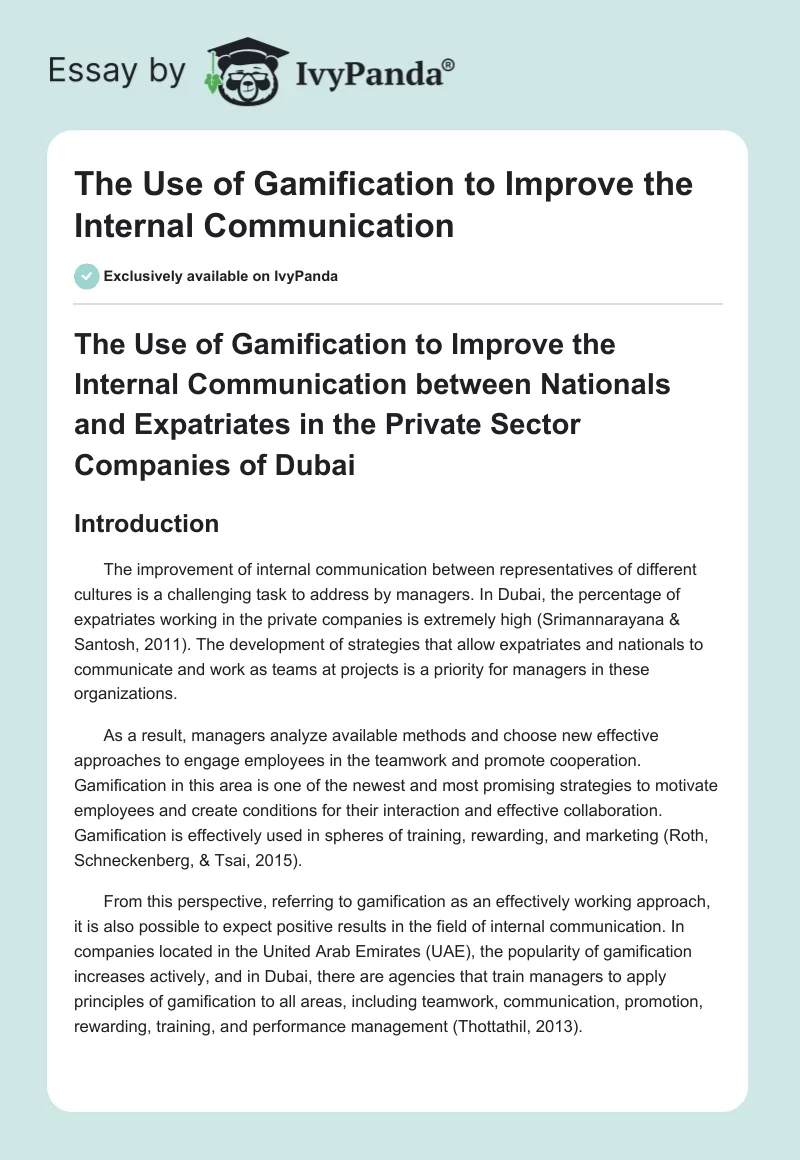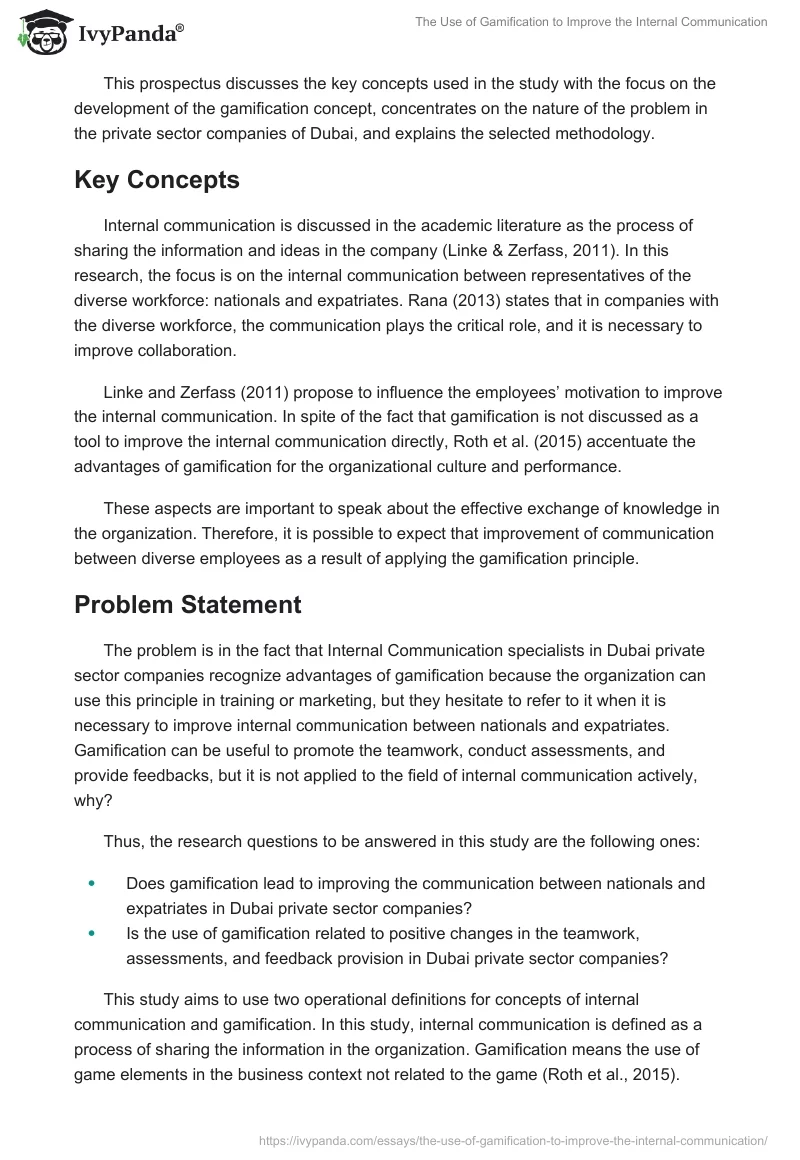Introduction
The improvement of internal communication between representatives of different cultures is a challenging task to address by managers. In Dubai, the percentage of expatriates working in the private companies is extremely high (Srimannarayana & Santosh, 2011). The development of strategies that allow expatriates and nationals to communicate and work as teams at projects is a priority for managers in these organizations.
As a result, managers analyze available methods and choose new effective approaches to engage employees in the teamwork and promote cooperation. Gamification in this area is one of the newest and most promising strategies to motivate employees and create conditions for their interaction and effective collaboration. Gamification is effectively used in spheres of training, rewarding, and marketing (Roth, Schneckenberg, & Tsai, 2015).
From this perspective, referring to gamification as an effectively working approach, it is also possible to expect positive results in the field of internal communication. In companies located in the United Arab Emirates (UAE), the popularity of gamification increases actively, and in Dubai, there are agencies that train managers to apply principles of gamification to all areas, including teamwork, communication, promotion, rewarding, training, and performance management (Thottathil, 2013).
This prospectus discusses the key concepts used in the study with the focus on the development of the gamification concept, concentrates on the nature of the problem in the private sector companies of Dubai, and explains the selected methodology.
Key Concepts
Internal communication is discussed in the academic literature as the process of sharing the information and ideas in the company (Linke & Zerfass, 2011). In this research, the focus is on the internal communication between representatives of the diverse workforce: nationals and expatriates. Rana (2013) states that in companies with the diverse workforce, the communication plays the critical role, and it is necessary to improve collaboration.
Linke and Zerfass (2011) propose to influence the employees’ motivation to improve the internal communication. In spite of the fact that gamification is not discussed as a tool to improve the internal communication directly, Roth et al. (2015) accentuate the advantages of gamification for the organizational culture and performance.
These aspects are important to speak about the effective exchange of knowledge in the organization. Therefore, it is possible to expect that improvement of communication between diverse employees as a result of applying the gamification principle.
Problem Statement
The problem is in the fact that Internal Communication specialists in Dubai private sector companies recognize advantages of gamification because the organization can use this principle in training or marketing, but they hesitate to refer to it when it is necessary to improve internal communication between nationals and expatriates. Gamification can be useful to promote the teamwork, conduct assessments, and provide feedbacks, but it is not applied to the field of internal communication actively, why?
Thus, the research questions to be answered in this study are the following ones:
- Does gamification lead to improving the communication between nationals and expatriates in Dubai private sector companies?
- Is the use of gamification related to positive changes in the teamwork, assessments, and feedback provision in Dubai private sector companies?
This study aims to use two operational definitions for concepts of internal communication and gamification. In this study, internal communication is defined as a process of sharing the information in the organization. Gamification means the use of game elements in the business context not related to the game (Roth et al., 2015).
Methodology
The mixed method approach is selected for the study. The quantitative information will be collected with the help of the survey, and the qualitative data will be collected as a case study.
Variables
The independent variable in the research is the use of gamification. The dependent variable is the internal communication measured in relation to positive or negative changes. The purpose of the research is to study whether there is a relationship between gamification and any changes in the internal communication. For answering the second research question, the focus is on measuring the presence of positive changes in internal communication and other aspects of the employees’ interaction.
Sampling
The study will focus on examining gamification in one company representing the private sector of Dubai where it is used not only in management but also in internal communications. The sample for the survey will include nationals and expatriates that will be selected with the help of a stratified random sampling (Chambliss & Schutt, 2013).
It is expected that the sample will represent males and females from the 18-45-year-old age group. This approach to sampling allows examining attitudes to the gamification of both nationals and expatriates. For the case study, the sample will include Internal Communication specialists working in the company.
Methods
The quantitative cross-sectional survey is chosen to assess the extent to which the use of gamification in the area of internal communication contributes to the productive interaction between nationals and expatriates. Advantages of the cross-sectional survey are in possibilities to receive questions to answers quickly and at low costs. Disadvantages include the impossibility to check the influence of external factors on answers (Reagan, 2006).
This limitation is addressed with the help of using the case study approach to gain the qualitative data on the gamification strategy in the company. The advantages of the case study are in possibilities to focus on the experience of the concrete company basing on interviews and the review of documents (Berger, 2014). Weaknesses of the case study approach are addressed while combining it with the quantitative method.
Instruments
To conduct the survey, it is necessary to use the questionnaire structured with the help of the Likert scale indicating the extent to which employees discuss the gamification strategy in the internal communication as positive. The use of the questionnaire based on the Likert scale is supported by the necessity of adapting the qualitative answers to measuring them with the help of quantitative tools (Chambliss & Schutt, 2013).
To guarantee the high level of reliability, the questionnaire on gamification will be retrieved from the existing literature. Questionnaires will be sent to participants via e-mail. For the case study, instruments include the structured interview questions to communicate with the Internal Communication specialists. The other data on the use of gamification will be collected referring to the corporate documentation.
Conclusion
The study on the problem of using gamification to improve the internal communication of nationals and expatriates in the private sector of Dubai will utilize the mixed methods in order to explore the problem in detail and determine possible relationships.
The focus is on using the questionnaire and a case study approach. The proposed study will allow concluding about the effectiveness of using gamification in the sphere of internal communications and provide the results of the quantitative and qualitative assessments to support the conclusions.
References
Berger, A. A. (2014). Media and communication research methods: An introduction to qualitative and quantitative approaches. New York, NY: Sage Publications.
Chambliss, D. F., & Schutt, R. K. (2013). Making sense of the social world: Methods of investigation. New York, NY: Sage Publications.
Linke, A., & Zerfass, A. (2011). Internal communication and innovation culture: developing a change framework. Journal of Communication Management, 15(4), 332-348.
Rana, R. (2013). Effective communication in a diverse workplace. International Journal of Enhanced Research in Management and Computer Applications, 2(2), 1-5.
Reagan, J. (2006). Applied research methods for mass communicators. New York, NY: Marquette Books.
Roth, S., Schneckenberg, D., & Tsai, C. W. (2015). The Ludic drive as innovation driver: Introduction to the gamification of innovation. Creativity and Innovation Management, 24(2), 300-306.
Srimannarayana, M., & Santosh, K. M. (2011). A study of human resource issues in Dubai. International Journal of Economics and Management Science, 1(1), 55-66.
Thottathil, M. (2013). Gamification set to increase corporate growth in 2014. The Arabian Gazette. Web.


